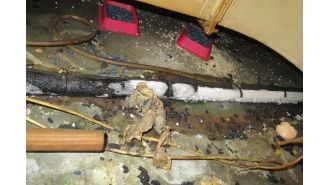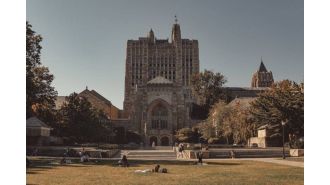Life and Death, But No Trash Pickup: Diary of a Young COVID-19 Nurse
Despite all the talk about appreciating health care workers, one California nurse caring for the sickest patients felt she needed more support.

When a 27-year-old critical care nurse volunteered for Santa Clara Valley Medical Center’s COVID-19 unit last month, she knew that caring for patients with failing lungs and an untreatable disease would be frightening and heartbreaking. What she didn’t expect was to be shunned by fearful workers in other departments, surrounded by uncollected trash and forced to use up health benefits on a technicality.
She had graduated from nursing school in 2017 and worked for a year at an urban hospital in the Midwest. Last fall, she joined the staff of Santa Clara Valley, a public hospital in San Jose, California. She had barely acclimated to her new job before patients began testing positive for COVID-19 in February.
Santa Clara County had several of the earliest confirmed cases of COVID-19 in California, including what are now the first two known coronavirus-related deaths in the U.S. More than 1,900 people in the county have tested positive and 94 have died, according to the Johns Hopkins University COVID-19 dashboard. As of Wednesday, 52 employees at Santa Clara Valley had tested positive, according to the hospital.
In a written statement, Santa Clara Valley acknowledged its health care workers have been under significant strain during the pandemic.
“Protecting our healthcare workers and our patients, including our patients’ privacy, is our highest priority,” the hospital said. “We understand this is a very stressful time for our staff, particularly those who are on the front line caring for patients. We truly appreciate and care deeply about all of our healthcare workers and all of our patients and remain committed to doing everything possible to ensure everyone is supported and safe.”
The nurse spoke with ProPublica reporter Ryan Gabrielson at least twice a week throughout late March and April, describing her experience. She requested anonymity for fear of online harassment or career repercussions. The following is an edited transcript.
With few volunteers for the hazardous duty, staffing of the COVID-19 unit is left to the luck of the draw.
“When the COVID-19 unit opened in early March, we opened it in one day. It’s a pandemic and no one had time to really prepare. We didn’t have a process for how to select who goes there to work.
Assignments are normally based on rank. It’s union policy. The nurses working as per diem, as extra help, they don’t get health benefits but they get paid a ton per shift. So they’re the ones who have to float on whatever units the nursing office needs them on. Per diem people were being forced to float almost every single shift to the COVID unit.
It got to be too much for one of them. He just started yelling at the charge nurse. They were both under so much stress and really angry at each other. She didn’t want to change things after she had already planned it out. And he didn’t want to go again to the COVID unit. It wasn’t fair for him to go so much when some staff nurses didn’t have to.
There were days where no one volunteered to go, and after that argument, the charge nurses didn’t force it anymore, because it was unfair. They asked if there were any volunteers, and no one wanted to. The medical ICU nurses, we agreed to change the process, to be fairer.
It was 10 minutes before the shift started and the charge nurse had to choose someone to go. And you have to do it quickly because no one likes to lose time. You want to be ahead of your work, because it’s a super stressful job anyway.
We came up with something on the spot. It was kind of funny. We have these patient belongings bags, they got one of those. The nurses wrote their names on pieces of paper and put them in the bag, and the charge nurse just drew a name. Whoever got picked got up to go to the unit.
One day last week, they were going to start drawing names again, so I told them: ‘I volunteer. I’ll go.’
I live with just one other person, my boyfriend, who’s also isolating. I’m fairly young and healthy. He’s fairly young and healthy. I’m extremely cautious; my first degree was in microbiology, so I bleach everything. I felt like I was in a better position to not get sick or, if I got sick, to recover faster.
Plus, there’s too much uncertainty with this virus going around. I’d rather have a patient I know is positive.”
In its written statement, Santa Clara Valley said nurse assignments to the COVID-19 unit are rarely left to chance, except when choosing between two “floaters,” or nurses who move from one unit to another. “For the COVID-19 unit, the hospital does ask for volunteers first because there may be nurses who want to work on that specific unit, but if there are no volunteers, then the float log will be used,” it said. “The only time there may be a situation of picking names from a bag is the unusual occurrence where there are two people with the exact same float date and no volunteers.”
When the nurse felt ill, she got herself checked for COVID-19. But policies were changing on the fly.
“There’s a lot of paranoia going around, and I was really worried a couple weeks ago because I was sick with sort of atypical symptoms.
I insisted on getting swabbed. Then I had to call in sick until I got my results. It was a whole thing; it took a very long time and I lost all of my sick leave during that wait.
The policy was changing really frequently that week, it was the middle of March and it was chaotic for everyone. Originally they told us if we are tested we’ll be put on paid administrative leave. I got tested on Wednesday and I called my nurse manager and the employee health department. They said different things. My manager said I’d go on paid admin leave. Employee health said it was up to the manager’s discretion, but we’re supposed to use our sick leave unless we were exposed.
I was working in the COVID ICU, I was exposed every day.
Turns out, the hospital changed policy the next day and said if you’re using PPE, you’re not considered exposed, which is unfair because we’re reusing PPE in a way it’s not meant to be reused.
On Friday, I got a call from my nurse manager saying that since I wasn’t technically exposed, I didn’t meet the criteria to be swabbed or tested. She couldn’t put me on paid admin leave, it was denied by the hospital. It was all coming out of my sick leave.
I asked her: ‘Can I go back to work then? I’m afebrile, my symptoms have resolved and it looks like a cold that was really bad for one day.’ She said, ‘Sure.’ It was 3 in the afternoon. At 6:30, employee health called and said I can’t go back to work until I get my results.
I remember specifically saying, ‘If I don’t qualify to be tested, then why can’t I go back to work?’ She said, ‘Because it’s policy, you’ve been tested, now you can’t return.’
I didn’t get my results until Sunday. They were negative, and I finally got to go back to work that day.
This is encouraging people not to be tested because we don’t want to lose all of our sick leave. They’re not intentionally doing that, but that’s definitely an outcome. What if we fall sick later during this pandemic? Since this all happened, the hospital started giving nurses 80 hours of paid leave while we wait for test results.
It’s kind of disappointing, to find out that you weren’t positive and you might still get sick and be hospitalized and go through what your patients are going through.”
Santa Clara Valley confirmed that employees with symptoms are not allowed to work until the hospital has received test results and that it now provides 80 hours of emergency paid sick leave for all COVID-19 related absences. “We currently have expanded and rapid testing capacity where results are returned in much shorter time frames,” the hospital said.
Constantly exposed to the virus, she prepared for the worst.
“A lot of people that I work with are sleeping in separate rooms from their partners. They’re getting undressed in their garage after finishing a shift so they don’t bring dirty scrubs inside. One of my friends has a 2-year-old daughter that she sent to live with her parents weeks ago, because she doesn’t want to get her daughter sick.
When we started seeing COVID patients in the community, my boyfriend and I discussed what we would do if we get sick.
I said, ‘Hey, I’m going to be working in the COVID unit, we’re both going to have to isolate.’
I might get more sick than someone who just has, like, a passing meeting with someone who’s COVID positive. I’m exposed to a much higher viral load, so it could hit me all at once.
If I start feeling sick, I’ll limit contact with my boyfriend as much as possible. We are lucky we have an extra room in our house, not the norm for most people in the Bay Area. I would sleep in the spare room and use the spare bathroom. He would leave food for me outside the door, on the hallway floor.
We don’t go out anywhere, we can’t get our own groceries, we’re pretty much under the impression that we’re infectious all the time, just in case. We drive around to get fresh air and wait to go out on walks when it’s raining so that we don’t run into other people.
My boyfriend’s parents and his grandfather both live pretty close to us and normally they’d come over frequently. All three of them are high risk, from age and comorbidities. They haven’t been in our house for a month, he hasn’t been to their house or hugged them or anything.
They bring food to our house when they take walks and wave to us from outside. We have conversations through the door.
My boyfriend’s very concerned, he doesn’t want us to get sick at the same time. If that happens, he won’t ask his parents for help, and obviously I won’t ask my parents for help. So if both of us are really, really sick, but not sick enough to go to the hospital, we will be stuck taking care of each other.
We’ll be alone.”
The nurses had never seen anything quite like COVID-19 before.
“We get some patients that are really, really stable. Then we get some patients where, you look at them, and you’re not sure how they’re still alive after a week.
Many of our sickest patients are relatively young. It’s kind of freaking out some of my co-workers.
There’s no clear reason why COVID made these guys so sick. They don’t really have much of a medical history, apart from maybe having an infection a week before they got sick. An infection lowers your immune system, and maybe it makes you more susceptible to a very severe COVID infection.
Some of them smoke, that’s the only other thing. Not all of them, and they weren’t chain smokers.
One guy, his chest X-ray looks better than others on the unit, but he’s not doing well. He still fights the ventilators if we pause the vecuronium [a drug that relaxes the skeletal muscles], for even a little bit of time.
Another patient arrived at the emergency department in full-blown hypoxic respiratory failure, there wasn’t enough oxygen going into his brain and the neurons started to die. You normally want to have a blood-oxygen saturation of 92 to 100. His was far lower. Which is, like, how are you alive? I’ve never had a patient that bad before.
I’m worried he won’t make it. Even if he survives, he’s probably going to need a lung transplant. What I’ve seen on his chest X-rays, it doesn’t look like there’s any function. He’s still breathing, still getting oxygen. But listening to his lungs, it sounds like a dishwasher, you just hear water.”
With other workers scared of even indirect contact with COVID-19 patients, nurses have taken on cleaning jobs.
“Auxiliary staff in the hospital are starting to avoid our COVID unit. Environmental services, the custodians, they don’t want to go in the patient rooms. Some nurses agreed to clean everything to help protect the rest of the hospital from exposure. Now we take out our own trash. I get really frustrated sometimes. It’s one thing for the nurses to do it to be nice, but we’re not getting any bonuses. They won’t empty the sharps container for needles and other dangerous medical waste. They’ll just give us one and tell us to put it on the ground in the room. Now we have trash all over the floor until we get a chance to sweep it up. Our nurse manager offered to take out the unit’s trash for us, which was really nice. She comes into the unit and talks to us in person.
A few days ago, the plumbers refused to go into a room when the toilet backed up. We literally gave a nurse a plunger and told him to go unplug it. And he did, because he had no other choice.
I’m sorry, if someone tells me that I need to unclog the toilet, I will lose it. I will absolutely lose my mind. We’re an ICU, we had someone code last night.
There was a custodial worker today who refused to clean another room that was empty and had been empty for over 12 hours. It’s like any hospital room, you don’t know what’s living in there. We have C-diff patients all the time and it’s not like you want to get C-diff either. That’s a spore that’s very hard to kill. There’s so much misinformation about COVID. People are scared and it gives the unit a stigma.
A pharmacy technician told us that she’s not comfortable going into the COVID unit and refilling our pyxis, the med dispensing machines. It is in a completely different location. It is not in a patient room. She wore an N95 just to go into the unit and restock our machine when all of us around her were not wearing N95s. In the hallway we’re wearing our surgical masks. And I know that she’s probably going to take it off the minute she goes out of our unit, and there’s no point, she used it for five minutes.
Maybe they’re living with someone who has asthma or is immunocompromised or something. Not everyone can self-isolate. We get desensitized to the danger. I need to keep that in mind.
We’re getting more and more exposure. We’re seeing other units getting things that we’re not getting. All donations go through the command center, so we don’t know what we’ll get or when.
They’re saying it’s a safety argument. When I asked if I could earmark donations specifically for our unit, they said that I could try to do that, but if they’re needed in other places the resources have to go there.
We still have PPE, but we have no idea how much we have left, everything is under lock and key. They keep telling us not to worry about it, but they also start locking up more and more things. We seem to be running out of gloves, those are now being locked up. I’ve heard we’re running out of disposable stethoscopes, so we’re going to have to start bleaching our own stethoscopes. The N95s, the face masks and CAPR shields have already been locked up for weeks now.
We don’t know where the future is going here. And I think that’s more stressful to us.”
Santa Clara Valley said that it currently has “sufficient” PPE. “The hospital needs to monitor and control the usage to ensure that PPE is appropriately used,” it said.
“To minimize the number of people who enter the patient room, nurses do collect trash, linen, and sharp containers and hand to housekeeping staff outside the room,” the hospital said.
COVID patients have to be flipped onto their stomachs to keep their lungs open, but some don’t survive it.
“Our COVID patients have ARDS (Acute Respiratory Distress Syndrome), so we pronate them, we put them face down. It helps lungs stay open because the only thing that would compress them is the spine. When you’re on your back, all of your internal organs compress your lungs.
We’d never pronated before and we practiced on one of the nurses. We figured out how to do it safely.
But as you can imagine, it’s kind of hard to do that in an ICU when someone is intubated and has a bunch of IV lines. They’re knocked out when they have really bad ARDS, paralyzed and sedated. They’re dead weight and very heavy. It takes, like, six people. Two RT’s (respiratory therapists) to deal with the tube, two nurses, two doctors. All those people to flip the patient over and we do it every six or eight hours. We have to turn their heads every two hours. Otherwise it’ll cause pressure injuries to the face, corneal abrasions, really bad damage to the eyes.
In our ICU we talk about the turn of death. There are patients who are really unstable and you just turn them a little and they code. Our nurse manager is buying beds specially made to help pronate patients, which is gonna be a lot of help. She’s very protective of her nurses.
We are full on the COVID unit. We found out last shift that a negative pressure room didn’t have negative pressure. It’s supposed to be a specially designed patient room that keeps air inside the room so staff and patients in the rest of the unit won’t be contaminated. The hospital was cautious and set up every COVID room that way, which is a luxury other places don’t have.
But things go wrong, machines break. The patient in that room was intubated and might have had treatments that aerosolized the virus and would have spread it throughout the whole unit yesterday. Nobody knew, so no one was wearing their N95s in the hallway.
We told everyone to put on their N95s and moved the patient into a working room. Not a big deal, but now we have one less room available for other COVID-positive patients.
We actually check the negative pressure every shift. It’s very archaic: We used a syringe like the ones that take snot out of kids’ noses. We filled it with charcoal powder and squeezed it in front of each room and saw which way the powder went.
The weird thing is we have an alarm if the pressure isn’t right. If someone leaves the room doors open, that alarm will go off. So the fact that the alarm didn’t go off is kind of worrying. How long had the room not been working properly? The high-tech thing is supposed to tell us.”
On April 10, the Los Angeles Times revealed a complaint by an anonymous Santa Clara Valley Medical Center employee that hospital administrators had not informed staff of a potential outbreak among nurses. It was news to her.
“I was so worried. The nurses work on a medical-surgery unit on the same floor as the ICU. It’s not that close, technically, because we don’t give patients to them. Hospital admin sent an email to us saying they’re doing their best. And if you have any concerns, you should talk to us first, instead of going to national media.”
After a month, she left the COVID-19 unit.
“The last few days working COVID, I’ve been so stressed out, I’ve been missing things. There are a ton of travel nurses. They aren’t staff but fill in. Some don’t know how to chart in our system, documenting the patient’s condition and medications. It’s hard to feel sure things were done right with all the travel nurses, and I feel like I’m far too new to catch everything. I think they are training those travel nurses so we can rely on them if there is like a peak in hospitalizations. Luckily, it kind of looks like we’ve already had our peak.
There was a patient I had all of last week on COVID. After I left, his condition dipped. That’s what we see with a lot of the patients. They’ll go in, they’ll be OK on the ventilator for a week. And then suddenly they’ll start tanking. You have to put them on vecuronium, increase the air pressure to expand their lungs. It’s a crucial phase, maybe they’re gonna make it, maybe they won’t.
Afterwards, I stopped volunteering for the COVID unit. So last night (April 14), I was back in the medical ICU, my regular floor. And it’s just business as usual over there, apart from the fact that we have, like, no patients. The other patients aren’t coming to the hospital, maybe out of fear.
It’s weird, on the regular medical ICU, the lack of pandemic conversations. They talk about the nice stuff that happens now, the recognition that health care workers are getting because we’re getting a lot of it. This morning, all of the county police departments and the fire departments, they all lined up outside of the hospital to welcome the day shift.
There’s less concern about the whole pandemic away from the COVID unit. I never thought that work would be the one place where I wouldn’t hear about this constantly.
I missed the COVID unit a little last night, because every time a patient coughed or someone touched my workstation, I felt like I had to bleach it down and protect myself. Even if I’m not in the COVID unit, anyone could have it.”






